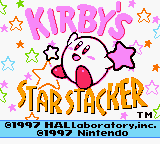Kirby's Star Stacker
| Kirby's Star Stacker |
|---|
|
Also known as: Kirby no Kirakira Kids (JP)
|
A Kirby puzzle game. It was an inevitability, really.
| To do: Check if there are any unused parts of the SNES version. |
Leftover Super Game Boy SOUND
| To do: Post rips. |
A list of Super Game Boy SOUND commands that is directly taken from Kirby's Dream Land 2 are located at 0xBC00. The only used sounds are the wind blowing during the intro and the clapping crowd played when a massive combo is achieved. Game Genie code ??3-01B-E6A will play any of the unused sound commands when the mute flag is called. The names used are from the official Game Boy programming manual following whether it is used or unused in either Kirby's Dream Land 2 or Kirby's Star Stacker.
Sound Effect Stopper
ID 00
Used to stop internal sound effects in both games.
Air-Sucking Sound
ID 10
Used for mounting Rick in Kirby's Dream Land 2.
Sound of Picture Floating Into View
ID 20
Used when mounting Kine in Kirby's Dream Land 2.
Sword Wielding
ID 30
Used when mounting Coo in Kirby's Dream Land 2.
Wind
ID 40
Used as a sound effect for Level 1 stage selection in Kirby's Dream Land 2.
Wave
ID 50
Used as a sound effect for Level 3 stage selection in Kirby's Dream Land 2.
Applause
ID 60
Used when clearing a massive combo in Kirby's Star Stacker.
Wind
ID 70
Used when selecting a level in Kirby's Dream Land 2.
Hurricane
ID 80
"Hurricane". Used as the opening sound effect in Kirby's Star Stacker.
Thunder
ID 90
Used as a sound effect for Level 7 stage selection in Kirby's Dream Land 2.
Regional Differences
Dialogue
| Japan | International |
|---|---|
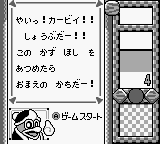 |
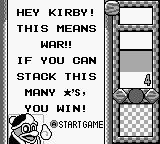 |
There's a border around game dialogue in the Japanese version. These border tiles were eliminated to make room for the extended alphabet.
Round Clear
| Japan | International |
|---|---|
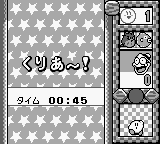 |
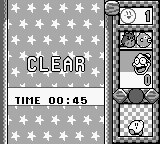 |
The stars in the clear screen are larger and flipped in the Japanese game.
Easy Mode Clear
| Japan | International |
|---|---|
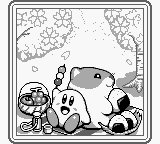 |
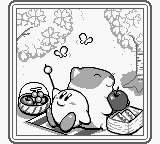 |
Kirby's Star Stacker takes a stand against multiculturalism, Kirby's pose was changed, Rick's eyes were closed, butterflies were added to the picture, and some of the leaves on the trees were very slightly changed.
Challenge Mode
| Japan | International |
|---|---|
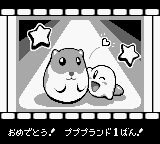 |
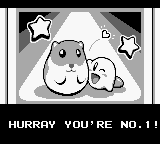 |
The Japanese game's challenge pictures look more like a photo reel. Again, the borders were removed to make space for new graphics.
Vs. Mode
| Japan | International |
|---|---|
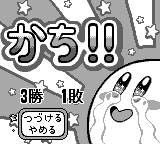 |
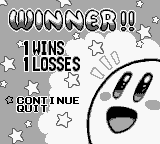 |
Kirby's rapturous expression was toned down in the international versions. The background was changed as well, most likely due to its resemblance to the imperial war flag, which is far more contentious outside of Japan due to its association with fascism.
Tutorial
| Japan | International |
|---|---|
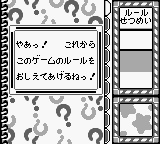 |
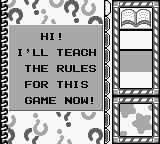 |
The usual border change. The Japanese text, "Explanation of rules", was replaced with an open book.
Records
| Japan | International |
|---|---|
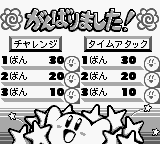 |
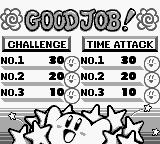 |
The boxes of text were expanded, and the odd shading by the difficulty icons was erased.
- Pages missing developer references
- Games developed by HAL Laboratory
- Pages missing publisher references
- Games published by Nintendo
- Game Boy games
- Super Game Boy games
- Pages missing date references
- Games released in 1997
- Games released in January
- Games released on January 25
- Games released in July
- Games released on July 7
- Games released in October
- Games released on October 20
- Games with unused sounds
- Games with regional differences
- To do
- Kirby series
Cleanup > Pages missing date references
Cleanup > Pages missing developer references
Cleanup > Pages missing publisher references
Cleanup > To do
Games > Games by content > Games with regional differences
Games > Games by content > Games with unused sounds
Games > Games by developer > Games developed by HAL Laboratory
Games > Games by platform
Games > Games by platform
Games > Games by platform > SNES games > Super Game Boy games
Games > Games by publisher > Games published by Nintendo
Games > Games by release date > Games released in 1997
Games > Games by release date > Games released in January
Games > Games by release date > Games released in January > Games released on January 25
Games > Games by release date > Games released in July
Games > Games by release date > Games released in July > Games released on July 7
Games > Games by release date > Games released in October
Games > Games by release date > Games released in October > Games released on October 20
Games > Games by series > Kirby series
The Cutting Room Floor > Unimportant Awards > Game Boy games
The Cutting Room Floor > Unimportant Awards > Game Boy games
